
By TAMELA BAKER, The Herald-Mail
HAGERSTOWN, Md. (AP) – Much of the cultural history of Hagerstown’s Black
community might have been lost, save for the efforts of one couple.
The collection of artifacts that the late Charles and Marguerite Doleman amassed
includes everything from antique dolls to clothing, ephemera and furniture. And
only a fraction of it is currently on display at the Doleman Black Heritage
Museum’s temporary home on the second floor of 35 W. Washington St. in
Hagerstown, a county-owned building that is also home to the Washington County
Treasurer’s Office.
Completion of the museum’s future home is still some time off, however, and
Project Director Alesia Parson asked the Washington County Commissioners
recently for a two-year extension on its West Washington Street lease.
“We have been able to fulfill our mission because of the assistance from the
county commissioners with that building,” she said. The museum has been leasing
all the rooms on the second floor except for an area that has now been vacated
by another agency, and she asked for permission to expand into that room for a
new project the museum has undertaken: recording oral histories.
“Most of African American history is documented only from stories handed down
from generation to generation, outside of the enslaved being documented as
machinery, chattel,” she said. “Most of our history is handed down from our
grandparents, or our great-grandparents or our great-great-grandparents.
“So what we would like to do is get those oral histories recorded, documented
and in our archives.”
Although the commissioners haven’t yet acted on the request, they were
enthusiastic about the museum’s future.
And they’re not alone. About 100 people gathered at the museum’s future site, a
former Coca-Cola bottling plant at 465 Pennsylvania Ave. in Hagerstown, when the
design for the new museum was unveiled in October.
“It’s amazing the buzz that this has created in our community,” Parson said. “I
will tell you, we are called often, asking, ‘So when is it going to happen?’ We
know it’s going to happen. We know that everyone in the community wants it to
happen.”
What can you see at the Doleman museum now?
Marguerite Doleman’s collection, which filled her home for decades, will be
showcased in two buildings designed to tell the story of the Black experience in
Hagerstown – along with additional artifacts that have been collected.
For now, about a fourth of the museum’s collection is on display at the
temporary location, Curator Wendi Perry told Herald-Mail Media. And in designing
the displays, she has attempted to maintain Doleman’s “homey” atmosphere.
Whips that were believed to have been used on slaves that were sold in
Washington County are on display at the Doleman Black Heritage Museum’s
temporary home on West Washington Street in downtown Hagerstown.
“So you have the dining room, you have the up-front room that had the African
art, and then as you moved through the house, you saw more and more things,”
Perry said. “The family basically lived among the artifacts, which is crazy for
me to think about, but it’s true.”
For the time being, “I sort of pick out things I think can be relatable to
people coming in, as well as really grand pieces – like some of the dresses and
things like that – that people don’t normally see because it is so dated,” she
said.
“As we go in the future with the new building … I hope to keep that kind of flow
because that was the spirit that she really wanted it to share: Being inclusive,
but also having pride in African American history and the heritage.”
Perry, who has a long résumé of museum administration that includes the Banneker-
Douglass Museum in Annapolis, is compiling “little bitty collections” right now,
she said, and focusing on archival documentation.
“(Doleman) has boxes and boxes of things that people have given her – family
Bibles, anything you can think of, as well as freedman papers and things like
that, that are framed.” Some are copies, but still help to tell the story.
Right now, she’s collecting “children’s books that focus on children, brown
children – basically what we’re calling little brown children’s books.”
She’s trying to make the museum’s appeal multigenerational. But the audience
she’s after is not just across generations, but across people groups.
“This history is not separate from anybody else’s history,” Perry said, “but
it’s been a long time in coming, to be inclusive. It all needs to flow together;
people say, ‘Why do you still need a Black History Month after all the things
that we’ve been through?’ Well, still a lot of the story hasn’t been told, and
it hasn’t been told in our voice; it’s usually somebody else telling our story.
“So Black History Month will be significant until it’s just automatically known.”
To that end, Perry said, the museum is doing everything it can to keep
educational programming going.
Not only do the displays include antiques from local families – clothing, for
example, and furnishings from the former Harman Hotel – but there are displays
of recent history as well. One display showcases hair care products produced
especially for Black consumers, and Parson’s program from one of President
Barack Obama’s inaugurations is framed and hanging on the wall. The museum
sponsored a bus trip to Obama’s second inauguration, in 2013.
Visitors are “amazed that the variety of things that are in here – it’s not just
one thing or two things, but even things that are everyday to them,” Perry said.
“When I started showing them some of the stuff, like the hair products and stuff,
African Americans – they know all of those products, because they’ve used them
before.”
There’s a whole 1940s kitchen with an icebox and other items still at the
Doleman home “that I haven’t even begun to pack up,” she said.
She’s already plotting exhibit designs for the new location. She hopes, for
example, to suspend a number of stained-glass windows that have been donated to
the museum. Only one, from the Ebenezer AME Church, is now on display.
Just a taste of what’s coming at the Doleman museum
Upon completion, the new museum site will include two buildings – the former
bottling plant, and an adjacent five-story building that will be constructed of
sea containers.
“That first building would actually be a revenue-builder for the organization so
that on Day One, when we open up our doors, we will have a consistent revenue
stream,” Parson told the commissioners.
Plans include a café, a gallery and a bookstore in the first building, she said,
and there are also plans for a studio.
It will take longer for the Coca-Cola building to be rehabilitated than
construction will take for the second building, Parson said, because the sea
container construction means it will be “prefabricated somewhere else. And then
it’s just like Legos. That building can be erected within two weeks.”
She also sees the projects as an economic development catalyst for the Jonathan
Street neighborhood.
“When we were looking for locations, we realized that there had not been an
economic development project within the Jonathan Street corridor outside of low-
income public housing,” Parson said. “So we want to create this economic
development anchor.”
Perry, of course, also looks at the project from a curator’s point of view.
“To me, this collection is what stimulates me,” she said. “The new building to
me means more opportunities to speak, to voice what we’ve come from, where we’re
going.”


